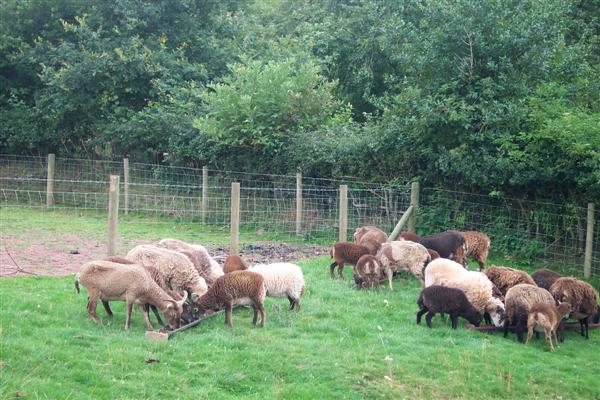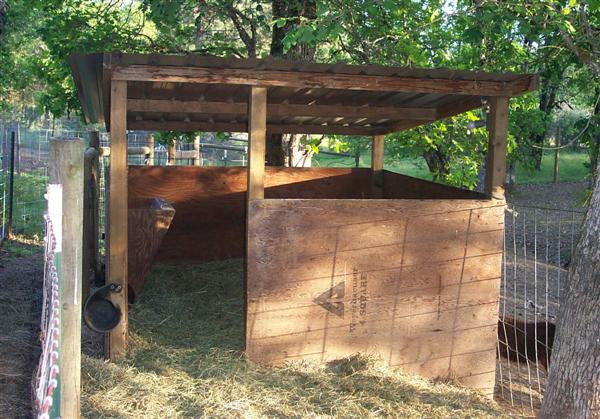Fencing Soay seem to bond with their living quarters and once bonded are content within the confines of their pasture, whether it is large or small, they don't challenge fences as goats do. In the UK Soay are often kept behind 33” (80cm) tall wire netting, but in the States we generally use 47” woven wire "field" fence. However, when frightened a Soay can easily jump over even a four foot barrier.
Some fencing ideas.
Fences do not have to be tall to contain Soay Sheep Because field fence has spacing of about 5"h x 6"w it can be a problem with lambs; when they are very small some can squeeze through the holes in the wire and when they are about two months old and their horns are developing they can push their head through the fence, get caught and are unable to pull their heads back out. Non climb horse wire fencing with its 2" x 4" spacing is one way around this problem, however it is three times as expensive as field fence which makes it cost prohibitive unless you are only fencing a small area.
Non climb horse fence with 2" x 4" spacing A more economical solution is the use of hot tape attached to the bottom of the field fence. While I am not a fan of hot wire with Soay sheep, I have heard too many horror stories of dead sheep in electric fences, especially electric netting, a single strand of electric tape placed about six inches above the ground has solved the problem of lamb's horns stuck in the field fences here. It seems that just one lamb needs to touch it with its nose and all the rest get the message to stay away. Keeping grass away from the tape so it doesn't short out is critical to success and in dry areas to preventing fires in the summer. Adult rams can get their horns tangled in it and so it is not recommended in ram pens. It isn't the answer for everyone but it has eliminated the problem with lambs on this farm.
47" woven wire "field"
fencing with approximate 5" X 6" spacing with electric tape strand at bottom
detail: hot tape attached to
t-post During the fall rut, when multiple rams are kept in adjoining
paddocks, they will also need to be separated by some type of visual barrier. There are
fewer if any skirmishes when they cannot see one another. In the past we have had great
success with tarps or old sheets of plywood temporarily hung on the fence, which
while they looked a bit "tacky" served the purpose very well. Recently a friend
and fellow breeder accidentally stumbled across the idea of using commercial weed barrier
hung on his fence as a curtain. It held up to the weather, was lightweight and easy to
hang, the sheep could not see through it and it was readily available on line and in farm
stores and garden centers. Whatever material you use make certain there are no "peep
holes" Soay sheep are very curious and they love peep holes.
Sheep Housing Systems: Sheds and
Barns Soay The Soay is a very adaptable animal, one of its strengths. We are often asked if it can tolerate the cold climates of the northern US or the hot climates of the south, in our experience it manages to adapt to both. But in spite of this hardiness it does need some protection from heat of summer and the wet of winter and a place where its hay can be kept dry. Rain and wind are the biggest concerns. Soay sheep have short wool with very little lanolin to protect them from the rain, if they get soaked in cold weather they are in trouble. On St. Kilda the sheep seek refuge in cleits or under rock outcroppings. In the early days we made very good use of the ubiquitous blue tarp, it served us well for a number of years as both shelter for the animals and for our hay. If you are on a shoestring budget it is a great way to start out. Eventually we were able to retire our blue tarps, we had actually graduated to brown, and found that a simple 8' x 8' pole shed with a slanting tin roof and plywood sides provided a very comfortable space for up to six or seven Soay. This can be a three-sided shelter (provided the rain and snow don't blow in), but a four sided building with a plywood door can make a convenient catch pen as well.
A simple shelter constructed of four sheets of 4’ x 8’
plywood, five 8’ 4 x 4 posts Ventilation is extremely important in a sheep barn and so the top portion of the shed has been left open to provide good air circulation, it also makes the buildings very convenient at feeding time. Our sheds have all been built along a fence line and the feeders all placed along the wall along that fence, this allows the hay to be dropped over the wall into the feeder without having to go through a gate into the paddock.
Some "instant" shelters An arched piece of cattle panel or a dog kennel
covered with a tarp make
Some Ideas for Pasture Shelter from the
UK
A few more ideas on portable farm buildings:
Sheep Barns One idea for a wooden sheep barn in Oregon Because we have had so many questions about shelter we have included a few photographs of the ideas we came up with for protecting our own sheep from the wind and rain in winter. After forty-five years of service my old pole barn, which had been lovingly built with scraps salvaged from the dump, finally gave out. It was a monument to recycling. The roof was sagging and the entire building kept listing a little further south with each storm. I also noticed that the roof was getting closer and closer to the ground and it would not be long before I was crawling in on my hands and knees to feed the sheep. I needed a barn to house the ewes and lambs, provide me with a catch pen, a work area and stalls that I could segregate animals with special needs- and it needed to be economical. Flexibility was also a primary objective.
Another idea for housing Soay sheep (in areas
where snow is not an issue) is a loafing shed. Half of this barn is devoted to the loafing
shed, the other half is divided into three parts, a small office for supplies and feeds
and two small stalls; one which serves as an "ICU" (intensive care unit) for
injured or sick animals the other for old rams that need to be separated from younger more
aggressive ones. The major consideration in the construction of this barn was the ability
to clean it out with a tractor at the end of the season. To that end standard 10' long
panels of pipe corral with horse panel (4" x 4" squares) attached to it was used
to divide the building in to two parts with an isle between the two sides. By simply
disconnecting the two pieces of corral in the middle and pulling them back, the tractor
has access to the entire barn. Stalls on the other side of the isle were created
with Shaul's Mfg lightweight gates and panels
which can also be easily be removed and put out of the way. A Steel barn with (Cinder) Block Walls in Wales
When we are ready to catch the sheep, one
outside gate is closed and the animals are herded into the double catch pens through the
other gate. Once all the Soay are inside the compound, the second outside gate is closed
behind them. With the animals now contained we can push them from the first pen through
the middle gate into the second (inner) pen which has a gate into the barn. Once confined
in the second pen, they have no place to go but inside the barn through the 4th gate.
Because the pens are located in front of their barn and thus, their feed, the sheep must
regularly pass through them to get to their hay and so are accustomed to this routine.
Further they are comfortable they have an avenue of escape because they can see the middle
gate is open but cannot see that the far gate is closed..
Soay Lamb Creep
Pen
Lightweight panels (US) and hurdles (UK) are easily transported and lock together with pins to make temporary containment pens. They can often be found at livestock shows.
Hay Feeders
Guess who came to dinner?
Supplement feeders We have found an evening supplement of mixed grains or a mixture of oats and a ewe/ lamb ration has kept our flock healthy, happy and especially tame. Dinner time comes and we are nearly trampled on both of our farms. In an attempt to keep one animal from hogging the entire evening’s ration we have used small rubber feed bowls, one for each sheep, screwed to the wall of the barn or inexpensive plastic rain gutter with two board "feet" screwed to the bottom (so the sheep cannot tip it over) as a grain trough. This can easily be cut to any size. For lambs our old chicken feeders have worked well. The Shaul's also make metal grain troughs in standard 4' and 8' lengths.
|
||||||||||||||||||||||||||||||||||
|




















 I
I

















